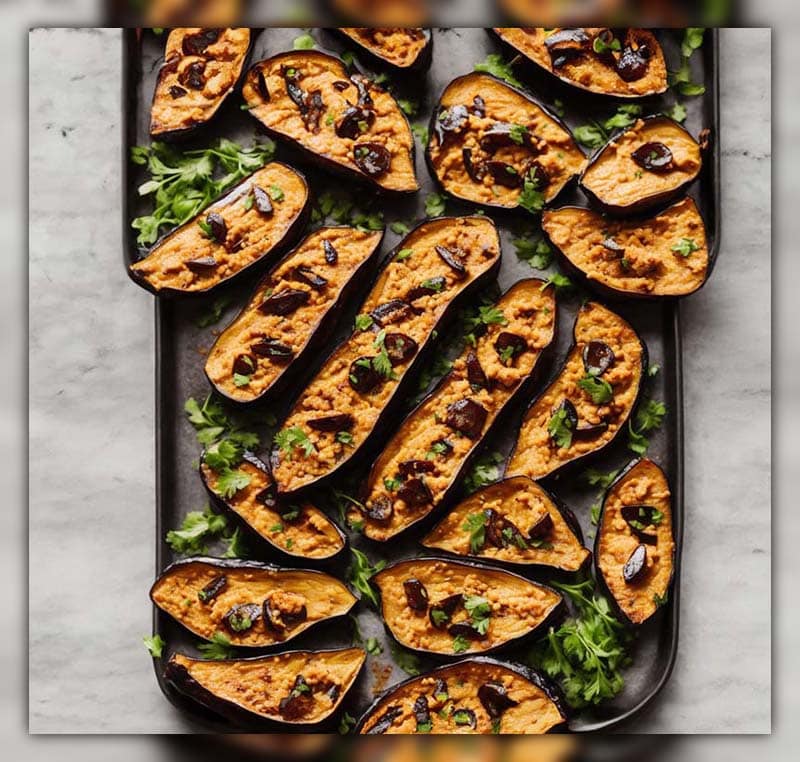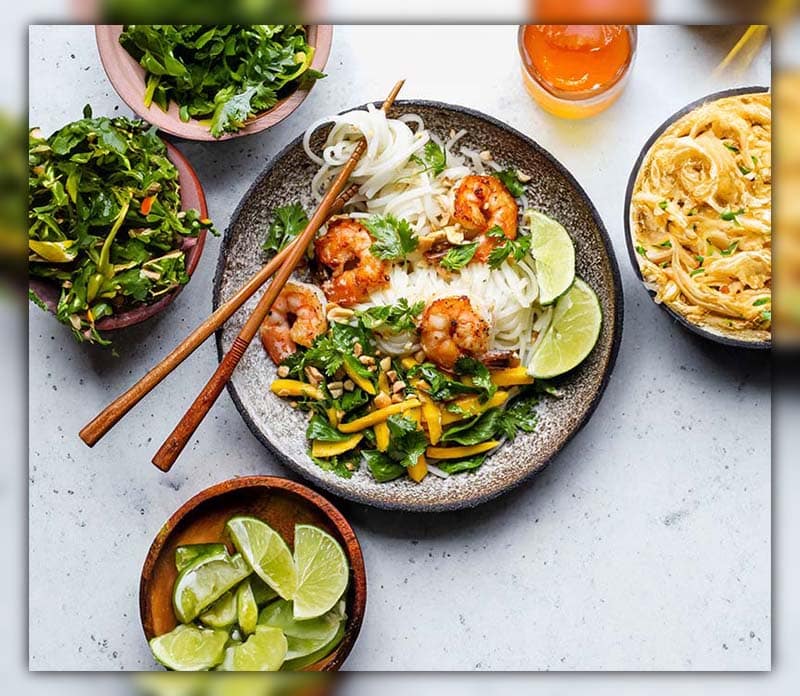Introduction
Weight loss, in essence, is about burning more calories than you consume. This guide dives into low calorie meals for weight loss, which offer nutrient-rich options between 400-500 calories. Learn their benefits, how to determine your needs, and prep tips for lasting results. Make them your key to a healthier you.
Benefits of Low-Calorie Meals for Weight Loss
Eating low-calorie high-protein foods for weight loss can really help when you’re trying to drop weight and feel better. Here’s why they’re beneficial:
- Lose Weight: When you eat less calories, your body uses up the fat it has stored. This means you can start to lose those unwanted pounds.
- Stay Energized: When your blood sugar is steady, you feel more awake and active all day.
- Digest Easily: Eating foods with fiber, like apples or broccoli, makes your stomach happy and helps things move along.
- Heart Health: Going low-calorie can help bring down high cholesterol and blood pressure. Your heart will thank you for it!
- Avoid Health Troubles: By eating this way, you can steer clear of problems like diabetes, heart disease, and some cancers.
Beyond weight management, a balanced diet offers numerous additional advantages:
- Stay Healthy: Making good food choices helps you avoid big health issues, like strokes or heart attacks.
- Keep Moving: When you eat a mix of carbs, proteins, and fats, you have all the energy you need for your daily stuff and workouts.
- Good Vibes: A balanced diet can help you feel better, both in your mood and in how you think.
- Happy Belly: Things like yogurt can be super for your stomach, helping you digest better.
- Think Clearer: Some eating plans, especially ones like the Mediterranean diet, might even help your memory.
- Control Sugar: If you’ve got diabetes, the right food can help you keep it in check.
- Tough Bones and Teeth: Eating foods with lots of calcium, like cheese or spinach, is key for strong bones and teeth.
How to Determine Your Caloric Needs
When setting a calorie goal for weight loss, two essential metrics to understand are your Basal Metabolic Rate (BMR) and Total Daily Energy Expenditure (TDEE). Once you’re aware of these, you can plan your low calorie meal plan for weight loss
BMR tells you the calories you’d burn just by resting, doing nothing. A popular way to estimate it is the Mifflin-St.Jeor equation:
For men: BMR = 10 x weight (in kg) + 6.25 x height (in cm) – 5 x age (in years) + 5
For women: BMR = 10 x weight (in kg) + 6.25 x height (in cm) – 5 x age (in years) – 161
Now, TDEE is about understanding how active you are in a day. It’s basically your BMR multiplied by an activity number that ranges from 1.2 to 1.9, depending on how much you move around.
When you’re aiming to lose weight, you’d want to eat about 500 calories less than your TDEE each day. On average, most grown-ups need between 1500 to 2500 calories daily.
Aiming to lose approximately 1 pound (or around 0.4kg) a week? Strive for a daily 500 calorie deficit. This can be done by eating less, working out more, or a combo of both.
How to Create a Balanced Low Calorie Meal
When reducing calorie intake, it’s imperative to ensure you still nourish your body with essential nutrients. For a low-calorie lunch recipes for weight loss, consider the following guide:
Big Building Blocks (Macronutrients):
- Protein: Helps you feel full and keeps your muscles strong. Try to get between 0.5-1g for each pound you weigh. Look for foods like chicken, eggs, fish, beans, and nuts.
- Carbs: Give you energy. Go for whole foods like whole grains, veggies, and fruits. And, it’s a good idea to cut down on sugars that aren’t natural.
- Fats: They’re important for your brain and hormones. It’s best to choose plant-based fats like those in olives or avocados. Also, fats from fish and nuts, called omega-3s, are a great choice.
The Little Helpers (Micronutrients):
- Vitamins and Minerals: These tiny nutrients do big jobs in your body. To make sure you get a mix of them, eat lots of different colored fruits and veggies. Think about adding greens, blueberries, oranges, and tomatoes to your plate.

5 Healthy Low-Calorie Recipes for Weight Loss
These dishes are light on calories (all under 500 per portion) but big on flavor, using wholesome ingredients like veggies, seafood, and lean meats. Plus, they’re quick to whip up!
-
Shrimp Sauté with Spinach & Feta Salsa
Ingredients:
- 1 lb. large shrimp, peeled
- 1 tbsp. olive oil
- 1/2 cup salsa
- 2 cups fresh baby spinach
- 1/4 cup feta cheese, crumbled
How to Make: Warm the olive oil in a skillet over medium heat. Toss in the shrimp and cook until they turn pink. Mix in the salsa and spinach, stirring until the spinach softens. Sprinkle with feta before serving.

-
Sweet Potato & Miso-Glazed Eggplant Steaks
Ingredients:
- 2 eggplants, thickly sliced
- 2 sweet potatoes, peeled & sliced
- 2 tbsp. miso paste
- 2 tbsp. olive oil
- 1 tbsp. honey
- 1 tbsp. rice vinegar
- Sesame seeds for garnish
How to Make: Preheat the oven to 400°F. Blend the miso, oil, honey, and vinegar in a bowl. Brush the mixture onto the eggplant and sweet potato slices on a tray. Roast for 20-25 minutes, sprinkle with sesame seeds, and enjoy.

-
Crispy Salmon & Seared Green Beans
Ingredients:
- 4 salmon pieces
- 1 lb. green beans, cleaned
- 2 tbsp. olive oil
- 1 tbsp. soy sauce
- 1 tbsp. honey
- 1 tbsp. mustard
- 1 garlic clove, minced
How to Make: Set the oven to 400°F. Combine the soy sauce, honey, mustard, and garlic. In a skillet, sear the salmon in olive oil until golden. Remove and place on a tray. Sauté green beans in the skillet until they’re slightly charred. Drizzle the sauce over the salmon and roast for 8-10 minutes. Serve with the beans.

-
Thai-Style Shrimp Noodle Bowl
Ingredients:
- 8 oz. rice noodles
- 1 lb. shrimp, peeled
- 2 tbsp. olive oil
- 1 red bell pepper, thinly sliced
- 1 cup snow peas
- Fresh cilantro & peanuts for topping
How to Make: Cook the noodles as instructed. Fry the shrimp in a skillet with olive oil until they’re pink. Add in the pepper slices and snow peas, cooking until just soft. Combine with the noodles, then top with cilantro and peanuts.

-
Sun-Kissed Chicken Burger
Ingredients:
- 1 lb. ground chicken
- 1/4 cup breadcrumbs
- 1 egg
- Fresh parsley, chopped
- Sun-dried tomatoes, chopped
- 1/4 cup mayo
- 1 garlic clove, minced
- 1 tbsp. lemon juice
- 4 whole wheat buns
How to Make: Combine chicken, breadcrumbs, egg, and parsley in a bowl. Shape into 4 patties. Sauté in olive oil in a skillet until thoroughly cooked. Mix the sun-dried tomatoes, mayo, garlic, and lemon juice to craft the aioli. Assemble your burger on the buns, adding a dollop of aioli on top.

7 Tips to Help You Lose Weight with Low Calorie Meals
To optimize your free low calorie meal plan, consider these strategic tips:
- Get Tech-Savvy with Calorie Apps: Tools like MyFitnessPal and LoseIt can help you log your meals and keep track of calorie intake. They’re like digital food diaries!
- Measure Before You Munch: Don’t just guess! Use a food scale to weigh out your portions. It’s an easy way to make sure you’re not accidentally overeating.
- Prep Ahead, Win Ahead: Set aside some time each week to prepare your meals in advance. This ensures you always have a healthy option ready and reduces the risk of last-minute unhealthy choices.
- Treat Yourself (Occasionally!): Everyone needs a treat now and then. If you know you’ve got a treat coming up, consider cutting a few calories earlier in the week to make room.
- Move That Body: Pair your meal plan with some physical activity. Whether it’s cardio, weight lifting, or just a walk around the block, it helps in burning those extra calories.
- Drink Up: But we’re talking about water! Staying hydrated can help with weight loss by making you feel full and boosting metabolism.
- Slow and Steady: Weight loss is a marathon, not a sprint. Stick to your plan, keep your calorie deficit reasonable, and you’ll see results in time.

What are some high protein, low calorie options for vegetarians and vegans?
Tofu, tempeh, seitan, edamame, lentils, chickpeas, almonds, quinoa, and peanut butter are good protein-rich choices.
Is calorie counting required on a low calorie diet?
Not always, but it helps. Calorie counting gives better portion control and ensures a deficit. Apps can make this simpler.
How can I stay satisfied on fewer calories?
Eat foods high in fiber and protein, drink water, space out meals and snacks, chew slowly, and enjoy small daily treats.
Are low fat foods always lowest in calories?
No. Some low fat foods have added sugars which increase calories. Always check nutrition labels.
How often can I have a high calorie meal?
You can indulge 1-2 times a week. Balance with lower calorie days to keep an overall weekly deficit.
Will eating too few calories cause my metabolism to slow down?
Yes, if you restrict severely. Less than 1200 calories may reduce metabolism over time. A moderate calorie cut won’t.
How can I maintain my lower weight after reaching my goal?
Keep a minor calorie deficit, continue exercising, monitor your weight, and stick to healthy habits like meal prepping.
What exercises burn the most calories?
Running, swimming, hiking, cycling, strength training, HIIT, and sports are among the top calorie-burning exercises.
Conclusion
Adopting a low-calorie meal approach can be pivotal in your weight loss journey and enhance overall well-being. Remember, the crux lies in striking the right balance between cutting calories and ensuring essential nutrition. As you explore low calorie meals for weight loss, we’d love to hear about your personal experiences and success stories with these meal plans.
Have any unique low-calorie recipes or tips? Share with the Bodyfitnt community! And don’t forget to explore more insightful blogs from Bodyfitnt to keep your health and fitness knowledge up to date.
Soruce:

Born on July 26, 1960, Professor Tim Olds is a leading authority in the field of health sciences, focusing on exercise science, nutrition, and well-being. As the Bradley Distinguished Professor at the University of South Australia, his research offers pivotal insights into the effects of physical activity, diet, and lifestyle on health outcomes for both men and women.
Having completed two PhDs, one in French Studies and the other in exercise science, Professor Olds has uniquely blended his academic background to explore the multifaceted connections between human behavior, physical fitness, and nutrition. His work in mathematical modeling of cycling performance, anthropometry, and trends in fitness and fatness has informed strategies for weight management and healthy living.
Professor Olds served as the Project Director for the Australian National Nutrition and Physical Activity Survey, examining how diet and physical activity influence health on a national scale. His work on the ADAPT Project, focusing on 3D anthropometry, further showcased his innovative approach to understanding human physicality.
With numerous influential publications, Professor Olds has contributed substantially to the public’s understanding of diet, weight loss, and personalized fitness strategies. His findings have been instrumental in shaping health policies and behavioral change programs aimed at improving individual and community wellness.
From exploring women’s health concerns to understanding men’s fitness needs, Professor Olds’s research transcends gender barriers and offers a comprehensive view of the role of exercise and nutrition in enhancing life quality. His enduring commitment to health education and advocacy continues to inspire people to make informed decisions for a balanced and healthy life.
Professor Tim Olds’s trailblazing work stands as a vital resource for anyone interested in embracing a healthier lifestyle, understanding the science of physical activity, or pursuing effective strategies for diet and weight loss. His academic excellence and practical wisdom make him an essential voice in the ongoing conversation about health and well-being in the modern world.
PUBLISHED ARTICLES
- Olds, T. (2012). Evidence for a Sugars-to-Mental Health Pipeline. Atherosclerosis Supplements, 13(4), 29-30.
- Olds, T., Maher, C., & Zumin, S. (2011). The evolution of screen time: What’s next? Journal of Physical Activity and Health, 8(2), 236-244.
- Olds, T., Ferrar, K., Schranz, N., & Maher, C. (2013). Obese adolescents are less active than their normal‐weight peers, but wherein lies the difference? Journal of Adolescent Health, 53(6), 768-774.
- Olds, T., Maher, C., & Matricciani, L. (2010). Sleep duration or bedtime? Exploring the relationship between sleep habits and weight status and activity patterns. Sleep, 33(12), 1576-1581.
- Olds, T., Ridley, K., & Dollman, J. (2006). Screenieboppers and extreme screenies: The place of screen time in the time budgets of 10–13 year‐old Australian children. Australian and New Zealand Journal of Public Health, 30(2), 137-142.
These published articles reflect Professor Tim Olds’ contributions to various aspects of physical activity, sedentary behavior, and health-related research. They provide insights into the intricate relationship between lifestyle choices and health outcomes


Say hello to a healthier, happier you! This remarkable product helped me drop from 95kg to a lean 65kg. click here to start your journey towards a fitter lifestyle!